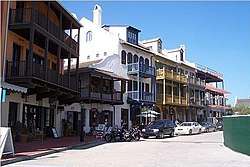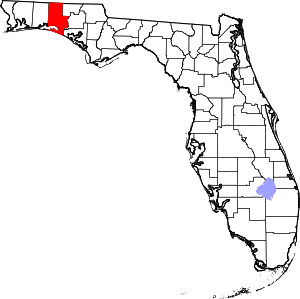Rosemary Beach, Florida
Rosemary Beach is an unincorporated planned community in Walton County, Florida, United States on a beach side road, CR 30A, on the Gulf Coast.[2] Rosemary Beach is developed on land originally part of the older Inlet Beach neighborhood. The town was founded in 1995 by Patrick D. Bienvenue, President of Leucadia Financial Corporation, and was designed by Duany Plater-Zyberk & Company. The town is approximately 105 acres (0.42 km2) and, upon completion, included more than 400 home sites and a mixed-use town center with shops, restaurants, and activities.
Rosemary Beach, Florida | |
|---|---|
 Downtown Rosemary Beach | |
 Rosemary Beach, Florida | |
| Coordinates: 30.27968°N 86.014479°W | |
| Country | United States |
| State | Florida |
| County | Walton |
| Elevation | 30 ft (10 m) |
| Time zone | UTC-6 (Central (CST)) |
| • Summer (DST) | UTC-5 (CDT) |
| ZIP code | 32461 |
| Area code(s) | 850 |
| GNIS feature ID | 1955359[1] |
Location
Rosemary Beach is located on the Gulf of Mexico in southeastern Walton County. U.S. Route 98 and County Road 30A are the main roads that run through the community. Via US-98, Panama City Beach is 16 mi (26 km) southeast, and Miramar Beach is 24 mi (39 km) northwest. County Road 30A parallels the coast westward, leading northwest 8 mi (13 km) to Seaside.
Design

Rosemary Beach is one of three planned communities on Florida's Gulf coast designed by Andrés Duany and Elizabeth Plater-Zyberk. The other two are Seaside and Alys Beach. The three are examples of a style of urban planning known as New Urbanism.
Rosemary Beach, designed in 1995, offers shops, restaurants, a hotel, and public green spaces.[3] The design of the town reflects New Orleans’ French Quarter[3] and European Colonial influences in the West Indies and Caribbean. Sustainable materials, natural color palettes, high ceilings for better air circulation,[4] balconies, and easy access to the beach by foot[3] are typical design features.
References
- "Rosemary Beach". Geographic Names Information System. United States Geological Survey.
- Kathleen Walls. "American Roads Travel Magazine". Retrieved 11 Jan 2014.
- Blackerby, Cheryl (2018-01-27). "Alys Beach: A stark, elegant example of New Urbanism". Palm Beach Daily News. Retrieved 2018-10-09.
- "Rosemary Beach: Our History". Rosemary Beach Property Owners Association. Retrieved 2018-10-09.
